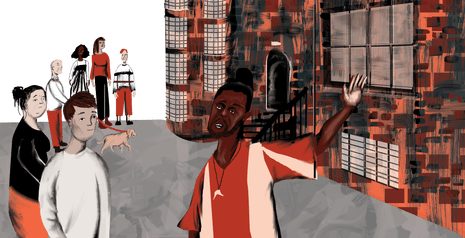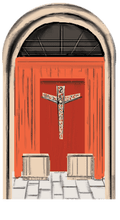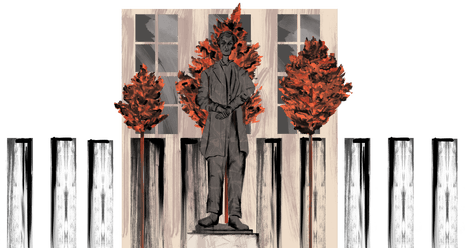
On a sunny June evening last year, members of the Manchester Literary and Philosophical Society filed slowly into the Friends’ Meeting House, just off St Peter’s Square. When the neat white building tucked behind Manchester Central Library was built in the 1820s, it became the base for the Quakers who led the abolitionist movement in the city. Now, in the same hall almost 200 years later, the second oldest learned society in the world gathered to examine its own links to transatlantic slavery.
Images of mills flashed up on a projector screen as the academic Alan Rice described how cotton powered Manchester’s transformation into a booming industrial metropolis. “If you’re in the business of cotton in the 18th and 19th century, you’re connected very deeply to the slavery business,” Rice, who runs the Institute for Black Atlantic Research at the University of Central Lancashire, told the audience. His next slide featured portraits of three of Manchester’s most prominent 19th-century industrialists: Samuel Greg, George Hibbert and Sir George Philips. Greg and Hibbert campaigned to preserve slavery and all three “owned” enslaved people (Philips, whose contemporaries dubbed him “King Cotton”, was among the first funders of the Guardian). They were also members of the Lit and Phil – like many prominent Manchester men of this era, who gathered at the society for lectures on science and the arts. A number of the city’s leading abolitionists, such as the physician John Ferriar and the clockmaker Peter Clare, were also members.
The kind of historical investigation conducted by Rice and his team of researchers has become increasingly common among British institutions seeking to excavate and analyse their own pasts. Many were prompted by the Black Lives Matter protests of 2020, but others were set in motion before.
In 2018, the University of Glasgow published the results of a year-long investigation into the “significant financial support” it had received from people whose wealth derived from slavery, and announced a £20m reparations package. Glasgow’s council commissioned its own report into the city’s ties to transatlantic slavery the following year.
In Edinburgh, academics recommended the city apologise for the role it played in sustaining chattel slavery. In Bristol, the city council voted for a parlimentary inquiry into slavery reparations. The Bank of England, the insurer Lloyd’s, the royal palaces, the National Trust, Kew Gardens, the Church of England, and the University of Cambridge have all launched inquiries into their own slavery connections.

But in Manchester, few other institutions have been so unsparing. The University of Manchester conducted research which found that some of its early supporters – including the Heywoods, who launched Manchester’s first bank – made their money from trading enslaved people. When asked if it might take action comparable to Glasgow’s reparations, the university said only that “at this time, nothing is off the table”. It plans to use the results of a staff and student survey to shape an official response, which is expected this year.
The city council has commissioned research canvassing opinion on Manchester’s public statues. But the civic institutions of the city that was built on slave-picked cotton have been in no rush to interrogate their connections to slavery. “It’s certainly not part of the official history,” said Dr Shirin Hirsch, a historian at Manchester Metropolitan University and the People’s History Museum – in part, she added, because the city’s connections to slavery were obscured by distance. Unlike Liverpool, where the city’s docks are an unavoidable reminder of its role as Britain’s main slave-trading port, Manchester had a more remote relationship with the enslaved people who produced its cotton. “It was literally called ‘Cottonopolis’,” Hirsch said, “but I think because it was not quite as direct [as other cities], it has been much easier to avoid that history.”
“People can point in Liverpool’s direction and say ‘look over there’,” said Dr Matthew Stallard, an academic who conducted the University of Manchester research. But in this regard, Manchester is emblematic of most of the United Kingdom; distance has always been crucial to minimising our ties to slavery. Being thousands of miles from the Caribbean, Alan Rice said, is what allowed Manchester’s cotton merchants to avoid opprobrium. “It allows this veneer: you have plantation wealth, but you don’t see the Black people producing it. You don’t see the exploitation, you just see the riches.”
Since 2007 Liverpool has been home to the International Slavery Museum, and there has been a sustained and successful campaign, led by Black Liverpudlians, to have the slave trade connections of places such as Bold Street (named after Jonas Bold, the sugar trader and former mayor of Liverpool) and Seel Street (named in honour of Thomas Seel, an enslaver and merchant) made obvious.
But in Manchester, you can walk down Brazil Street or past the cotton bud fountain in St Ann’s Square and have no idea of their links to chattel slavery. You can buy fashionable menswear and eat at a swanky restaurant in Manchester’s Northern Quarter that both use the city’s “Cottonopolis” nickname in their branding, completely untethered from its origins.
Walking around Ancoats, a former textile district where cotton warehouses have been turned into luxury flats, there are no signs of the neighbourhood’s connections to slavery. The city council has made no apology, and no study has been commissioned into how the profits of human suffering helped develop the world’s first industrialised city.
Today, some argue that contemporary Manchester has, like its pioneering industrialists, done a very good job at putting distance between itself and slavery.

Part 2: A wake-up call
The 200th anniversary of the 1807 Slave Trade Act, which ended the transport of enslaved Africans on British ships but not the practice of slavery in British territories overseas, was the occasion for widespread commemoration. Hundreds of organisations and societies across Britain marked the anniversary with new exhibitions and programmes, which celebrated the familiar and heroic story of abolition, but also prompted a renewed interest in the more contentious subject of Britain’s historic responsibility for the slave trade.
Alan Rice recalled his hope that the commemorations might produce a lasting change in Manchester’s sense of its own history. There were several events in the city: a play about cotton, slavery and the city was performed by Black schoolchildren at Quarry Bank mill; an exhibition on the abolitionist Thomas Clarkson was hosted by Manchester Cathedral, and the bicentenary freedom flag was placed in the town hall alongside an exhibition about Black soldiers.
Rice was invited by the Whitworth gallery to take part in the exhibition Trade and Empire: Remembering Slavery. The peer Lola Young, in the introduction to the show’s catalogue, recalled meeting people on her travels around the UK who proudly said their cities had nothing to do with slavery, and said she hoped these commemorations would be a wake-up call. All of this public history in 2007, Young wrote, should have “demonstrated a simple truth: there’s not a corner of the country where the impact of enslavement was not felt in one way or another.”
But to Rice’s frustration, the history of Britain’s connections with slavery has – for the most part – only become visible in these brief windows, without becoming lodged more permanently in our public memory. “There’s always opportunities,” Rice said, when I met him in the cafe of the Manchester Art Gallery – the same building where the African American abolitionist Sarah Parker Remond addressed crowds in the 1850s. “There could have been an opportunity in 2007.”
The Trade and Empire exhibition was part of a wider push in Manchester that year, which included Revealing Histories, a major project led by Rice and backed by eight Greater Manchester museums, including the Whitworth. Rice, the local historian Washington Alcott and other researchers produced videos and articles that highlighted Manchester’s slave trade connections. On the Revealing Histories website you can still find out about figures such as Henry Box Brown, an African American who escaped slavery by being delivered across state lines in a box and later lived briefly in Manchester, or the significance of sites such as Quarry Bank mill to the slave trade. But despite an impressive initial burst of activity, the project stalled. “The money ran out,” says Rice.

Alcott and the other researchers felt that momentum was building and that 2007 would be the start of a recalibration of Manchester’s history. Now, they felt, alongside the pride in industrialisation and scientific innovation, would be an acknowledgement of a more complicated narrative. “I’ve been involved with this stuff for long enough,” adds Rice, before pausing. “You think this emphasis can’t stop but it does.”
This was not the first time that efforts to highlight Manchester’s Black history had failed to take hold. Roots, a community arts and education project launched by the activist Elouise Edwards in the 1970s, struggled for years to get adequate funding. At one point the project, which included a festival and produced an alternative curriculum for schools that centred Black history, was run out of a cramped office in Moss Side.
Again, money – or a lack of it – meant the project’s lifespan was short. After Revealing Histories wound up, Alcott was invited to host slavery walks through Manchester during Black History Month every October. He remembers being confronted by Mancunians who would argue with him about the city’s slavery links. “Manchester is intimately linked with transatlantic slavery,” Alcott would explain. “Many people did not want to stomach that.”

Part 3: Deliberate amnesia
Just two years after the bicentenary celebrations, Manchester released a bold new version of its own history as part of a branding campaign called “Original Modern” – funded by the 10 local authorities in Greater Manchester, and produced by the PR firm Marketing Manchester.
“What Athens was to ancient Greece and Florence to the Italian Renaissance, so Manchester defined the urban, industrial age,” the historian (and later Labour MP) Tristram Hunt wrote in the introduction to a pamphlet launching the campaign. He argued that the city had been misunderstood: “This was a city of science and discovery: not just spinning jennies and beating looms, but John Dalton and atomic theory, James Joule and modern physics, later on, Alan Turing and computing.” Manchester wasn’t only about mills, cotton and hard graft – this was a city where “human and intellectual capital” reigned supreme and, crucially, we’d only partly grasped its history. “It was the original modern city,” Hunt wrote.
Hoardings went up with “Modern City” branding around Manchester construction sites, many featuring a multi-coloured “M” motif, designed by Peter Saville, and a series of milestones that painted a picture of the city’s evolution. “Modern computer science”, “votes for women”, “graphene”, “chemical engineering”, all sat together alongside “socialism”, “Coronation Street” and “Vimto” as a string of Mancunian achievements. Figures from history were picked out: Turing, Elizabeth Gaskell, LS Lowry and the Nobel prize winner Ernest Rutherford. Arthur Lewis, the St Lucian economist who taught at the University of Manchester, was the sole Black person named.
The Labour-led city council – headed by Richard Leese and Howard Bernstein – was selling Manchester to business and investors. The pitch worked. Investment would eventually come from China, Abu Dhabi and the chancellor, George Osborne, in the guise of his Northern Powerhouse project. While Hunt had mentioned the industrial heft of “Cottonopolis”, there was no reference to where that cotton originated. And overall the branding exercise ignored the slavery story, with only a mention of the city’s abolitionist movement included.

Much like the rest of Britain, which celebrates the decision to end the slave trade without much thought for its earlier participation, Manchester puts its abolitionists at the centre of its history.
Mancunian mill workers’ acts of solidarity with the enslaved – such as supporting Abraham Lincoln and the north in the American civil war – are emphasised. A statue of Lincoln, first erected in the city in 1919, stands as a symbol of Manchester’s support for the north in the civil war. The academic Dr Katie Donington wrote a book about the city’s prominent families – such as the Hibberts – and how knowledge of their connections to slavery eroded over time. She points out that solidarity against oppression “presents a version of local history and identity that sits more comfortably than the tale of exploitation and profit which the Hibberts represent”.
Sometimes the power of that story is remarkable. In 2022 Stallard attended a rally for the cost of living campaign Enough is Enough in Manchester Cathedral. Alongside the mayor of Greater Manchester, Andy Burnham, and union leaders, the dean of the cathedral, Rogers Govender, made a speech. “Right in the centre of his speech was Thomas Clarkson and the big abolitionist meeting at the cathedral in 1787,” says Stallard. “He talked about Manchester’s important place in the history of abolition, which is true and is a great history to celebrate. But there’s also chapels and memorials in that cathedral funded by Eleanora Atherton and other people who owned plantations. He didn’t mention that.” What is currently missed out matters, says Stallard. “There’s a ton of deliberate amnesia … Because everyone knows where the cotton came from. It’s not a secret, it is common knowledge.”

Part 4: Curricular activities
That lack of Black Mancunian history in the public realm has been repeatedly questioned by Black voices in the city. In the wake of Black Lives Matter protests in 2020, the council gathered Mancunians’ opinions on the city’s statues, including the Queen Victoria monument in Piccadilly and the Abraham Lincoln statue. One respondent said: “They represent true history. I am astounded that anyone could think about removing or replacing them.” More than 80% of the respondents were white, with around 2% identifying as Black and 0.3% as Black British, in a city with a Black population of more than 10% and where 40% are people of colour. Just under a third of those surveyed said “it was important to remember all of history”; there were also complaints about too many “Victorian industrialists” and others called for statues that “represent the African communities of Manchester”.
Only two statues in Manchester are of people of colour – Nelson Mandela and Mahatma Gandhi – neither of whom have strong ties to the city. As the local activist Deej Malik-Johnson has observed, “Manchester has more monuments dedicated to soft drinks than to its historic Black community”.
There is only one representation of a Black Mancunian in the public realm: Erinma Bell, the politician and gun violence activist from Moss Side, in an artwork made out of 50 firearms melted down and turned into a bust. “We don’t have the calls to tear down statues as much,” says Malik-Johnson, “because I think honestly, we’ve forgotten our own history.”

Part of that history is the 1945 Pan-African Congress. The event, held in the Chorlton-on-Medlock town hall, was a key turning point in African history, and was attended by many of the continent’s future leaders including Kwame Nkrumah and Jomo Kenyatta, alongside veteran pan-Africanists such as WEB Du Bois. They debated the postcolonial future of the continent, and the local Black population – led by the entrepreneur T Ras Makonnen – provided them with food and accommodation. Jonathan Schofield, a history tour guide in Manchester since the mid-90s, positions the Congress alongside the Peterloo massacre, the Chartist movement and the Trades Union Congress. “You can’t get away from it,” he says. “It’s radical history.”
Despite initial opposition from Manchester Polytechnic, which owned the site, local activist Kath Locke led a successful campaign to have a plaque put up on the venue.. “The Poly, interestingly enough, didn’t want to know,” Locke said in an interview shortly before her death in 1992. “But who cares about them? It’s something there for our children to see.”
The Pan-African Congress, like much of Manchester’s Black history, has not become a part of the city’s official story of itself – even though it would seem to chime with the image that Manchester wants to promote: rebellious, radical, inventive and original. “We’ve got a plaque for the fifth Pan-African Congress, but it’s a tiny little plaque … It doesn’t get that much attention,” says Keisha Thompson, the poet and chief executive of Contact theatre, who grew up in the city. “If we want to shout about abolition as a major chapter in Manchester’s history, then the Pan-African Congress should be in the same breath, right?”
There are groups in the city attempting to address Black history’s omission from the official narrative. The local historian Linford Sweeney has hosted Black history classes at the Manchester Central Library. Hirsch worked with a pub in Hulme to install a mural to commemorate Len Johnson, a communist antiracist activist and professional boxing champion, who protested against the colour bar. There has been a campaign to get a statue of Johnson, who was denied the chance to compete for the British title because of racist laws, erected in the city. The idea received backing from the council leader Leese and Burnham, but so far no official plans have materialised.
Black professionals in Manchester who have navigated the city’s institutions often paint a picture of a city that fails to accommodate them. Marcia Hutchinson, a Black former councillor, set up a talent pipeline for Black candidates to address the lack of racial diversity within the city council. Academics in the city’s universities spoke to me of being sidelined, saying that raising issues of race and racism often led to being ignored by colleagues, or to career stagnation.
In May 2022, the British Pop Archive – billed as the first “national collection dedicated to the preservation and research of popular culture” – was launched at the John Rylands library. Despite the contribution of Black Mancunian artists including A Guy Called Gerald, Hewan Clarke, Barry Adamson and Rowetta, a photograph taken of all those attending showed an almost exclusively white crowd. Two months later, the poet and then chancellor of the University of Manchester, Lemn Sissay (who stepped down after six years in the post last August) gathered Black and minority ethnic creatives from the city in the same space. The two images look like they come from parallel dimensions, one version of Manchester completely out of sync with the other. At the Lit and Phil event I attended there were only a handful of Black people in the audience. During the question-and-answer session, I asked why this was, and whether the society thought it was a problem. The exasperated answer from the chair was that they did not know how to attract Black members.
Part 5: Alternative vision
“The achievement of Caribbean people has tended to be masked by media images which focus on the folly of a few and, by doing so, diminish the accomplishments of the many,” wrote Elouise Edwards, the founder of the Black cultural festival Roots. Held in a school, the festival featured dancing and live music but had a clear mission: to teach local children, many of whom were Black, about their own history. At its inaugural event in 1977, Kath Locke gave a speech in which she talked about the history of Moss Side.
Locke and Edwards were two Black feminists who constantly agitated for resources and recognition for the city’s Black communities. Manchester-born Locke grew up as a pan-Africanist before she co-founded the Abasindi Co-operative, while Edwards moved to the city from Guyana in her 20s and alongside her husband, Beresford, became a senior community figure in Moss Side. In her speech, Locke mentioned the street names in the area that were named after local Black figures such as Sam Reid, the Oxford graduate from Jamaica who became a baptist minister in the city.
Roots produced an alternative curriculum that two local schools – Birley and Ducie – adopted. The new vision wasn’t simply to celebrate positive Black contributions; it also re-examined history. “These curricula do not have specific multiracial sections; rather all the subjects will be designed to show the historical input of non-European sources,” wrote Edwards. “For example, a history of the industrial revolution will not only describe the technological developments, but will also highlight how later the Indian cotton trade was virtually exterminated in order to maintain British profits.”
Keisha Thompson grew up in Whalley Range at a time when this alternative vision was being adopted. She remembers taking part in celebrations of various religions, and being taught about the negative effects of colonialism on the people of South America. She had lessons on Black history that “were just so expansive”, she says. “It wasn’t just like, ‘Oh, slavery, and this is where Black people begin.’ We were also being taught about intellectuals and people who were resisting in different ways, like Sojourner Truth.”
Last year, Thompson was invited by the Royal Exchange theatre to take part in its Disrvpt event. The project was designed by co-artistic directors Roy Alexander Weise (the theatre’s first Black director) and Bryony Shanahan to address the institution’s own connections to the slave trade. The theatre sits on the site of the former trading house (known as “the parliament of the cotton lords”) where Mancunian merchants sold and bought their goods. Thompson produced a poem called Holding Space, printed on a cotton banner, in which she wrestles with the space’s history. “Almost half the world’s cotton spindles threaded back to men who stood under these three domes,” she writes. “How many of us would be welcome in this scagliola room?” Some institutions have started to listen.

Part 6: A moment of reappraisal
Civic memory is not straightforward; it will always be contested. What is elevated and what is erased will continue to spark debates. These conflicts are alive and well in many of the world’s cities, but there is a renewed interest not only in what constitutes a city’s civic memory but who tells the tale.
In Berlin, the recently opened Humboldt Forum – built at a cost of €680m (£590m) on the site of a former imperial palace – has been described as a “Disneyland castle minus the fun” which projects “an image of an idealised past”.
In Russia, cathedrals have been rebuilt as monuments to nationalistic versions of the country’s history.
Other cities have moved to work collaboratively with community organisations to rethink and re-evaluate their civic memory. In 2020 and 2021, Los Angeles engaged with 40 historians, artists and “Indigenous elders” on a strategy to “engage more productively and honestly with its past – especially where that past is fraught or has been buried or whitewashed”. Recommendations included the creation of a “city historian position”.

Aboriginal artefacts held by Manchester Museum have now been returned to Indigenous Australians
In contemporary Manchester the aim is to follow Los Angeles’ example. But its plans have been criticised for being top-down and largely arbitrary. For example, the Gandhi statue erected in November 2019 was a gift from the Shrimad Rajchandra Mission Dharampur, a religious organisation. But there was pushback from activists who raised the Indian leader’s history of anti-Black racism. Yes, the city council has canvassed opinions on its statues, but the poor reach of its survey shows there are communities it hasn’t connected with.
The city is in a moment, like 2007, when history is again being reappraised. Institutions, particularly in the heritage sector, have begun to adopt progressive programmes to address historic grievances. In 2019, Manchester Museum handed back items that belonged to Indigenous Australian groups, and led a debate about what should be done about the 32,000 sacred Indigenous Australian objects held by British institutions. The same museum is working with the city’s south Asian community on a new gallery, canvassing opinion on what should be included and how it should be presented. In Manchester Central Library – across the road from the Friends’ Meeting House – the Ahmed Iqbal Ullah Centre specialises in the study of race, migration and anti-racist activism, and holds the Elouise Edwards archive.
The Cottonopolis research collective at the University of Manchester is examining the ecological legacy of Britain’s cotton empire. The Global Threads project – a collaboration between the Centre for the Study of the Legacies of British Slavery at University College London and Manchester’s Science and Industry Museum – has a specific remit to tell untold stories of the city’s cotton industry “particularly those related to colonialism, enslavement and global movements of people and goods”.
As with Revealing Histories, the combination of funding and institutional commitment will determine whether or not the projects survive, but if you look across Manchester today you see a city that is, in pockets, trying to expand the idea of Mancunian history and who is included in that. “I always oscillate, between the glass half full and the glass half empty,” says Stallard, who is working on Global Threads. “Because yes, there’s so much out there that hasn’t been properly researched and isn’t in the real public discourse or properly commemorated or marked or talked about, but we are in a better place than we were 10 or 20 years ago. Things do get better; things are more acknowledged, slowly, piecemeal.”
Tristram Hunt ended his introduction to “Original Modern” by positioning Manchester at the vanguard of new thinking. “So many of the new ideas that continue to shape our world first found their voice in Manchester,” he wrote. Now, as many British cities come to terms with their own history, can Manchester address its civic memory and lead again? Could the next new idea it embraces, actually be an old one? One put forward by Elouise Edwards and Kath Locke, one worked on by the Revealing Histories team and kept alive by Deej Malik-Johnson and Shirin Hirsch? The idea is simple: even though Manchester could easily hide its more controversial history or sideline those who promote it, instead it chooses not to. Manchester, the modern city, could once again do something radical.
The Guardian’s founders and transatlantic slavery: what should it mean? Join the Guardian’s editor-in-chief, Katharine Viner, the historian David Olusoga, the lead researcher Dr Cassandra Gooptar, and the Cotton Capital editor Maya Wolfe-Robinson for a special event as they discuss the Guardian’s two-year investigation into its founders’ links to the cotton trade and enslaved people. Chaired by the Guardian journalist Joseph Harker. Register here to join on Thursday 30 March, 7pm BST (2pm EDT)


